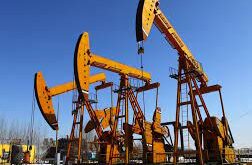The US oil industry is delivering a one-two punch to Middle East producers already reeling from a collapse in prices.
A tussle is playing out in the market for so-called light oils. which have a lower sulfur content and are less dense than heavier varieties.
When processed. these grades typically yield a higher amount of fuels like gasoline and naphtha. And now. American supplies are weighing on prices for such crudes as well as fuels made from them.
Light oil pumped in US shale fields is increasingly making its way to Asia. undercutting sales by the likes of Saudi Arabia.
Additionally. America is exporting a record amount of refined fuel. contributing to a global glut in gasoline and naphtha.
That’s hurting some of the biggest members of the Organization of Petroleum Exporting Countries as they prepare to curb crude output in a bid to stabilize the market.
Middle East producers — still the dominant suppliers to Asia – are being forced to tackle American crude competition by lowering their oil pricing to defend their market share.
The refiners. meanwhile. are contending with booming US fuel shipments dragging down their returns from making processed products.
“It is no surprise that Middle Eastern producers are having to cut light crude prices.“ said Virendra Chauhan. an analyst at industry consultant Energy Aspects Ltd.
Over the course of 2018. the key sources of global oil-output growth have included light crude from US shale fields and Saudi Arabia. he said.
While Middle East producers such as Saudi Arabia and Abu Dhabi are reducing the pricing for their lighter crudes. American exports to Asian nations such as India and South Korea are surging.
Even a temporary halt by China due to its trade war with the US hasn’t significantly dented overall flows this year.
While the rivalry between Middle Eastern producers and sellers of US oil has intensified since 2016. with even relatively heavier American crudes such as Mars and Poseidon coming to Asia. the competition is particularly stiff for lighter grades.
Abu Dhabi’s Murban and Saudi Arabia’s Extra Light have similar fuel yields and chemical characteristics as shale crude.
State-owned Abu Dhabi National Oil Co cut the premium for 2019 term supplies of Murban crude to 16-18 cents a barrel over its monthly official selling prices. down from about 25 cents in 2018.
Government-run Saudi Aramco slashed the premium of its Arab Extra Light grade over Middle Eastern benchmarks to the lowest level in 16 months.
They are not only competing with shale flows. but also with new regional varieties such as Umm Lulu and Kuwait Super Light.
Despite the recent price reductions. Middle Eastern light crudes remain relatively handicapped versus American oil ahead of 2020. when new international rules mandating the use of less-polluting fuel in ships take effect.
The sulfur content in grades such as Arab Extra Light and Murban is still higher than levels in US crude. meaning they need to be processed a bit more to yield cleaner fuels.
On the refined products front. rising shale production and its use in US refineries are leading to a domestic surplus of fuel that either gets exported to international markets. or displaces cargoes that move from Asia to buyers elsewhere such as Latin America.
Average US exports of oil products have risen 7% so far this year. data from the Department of Energy show.
America’s surplus of gasoline is estimated to swell by 80.000 barrels a day in 2019 as demand plateaus and domestic output climbs. according to ESAI Energy LLC. pushing daily exports of finished and blending material to over one million barrels next year.
“Excess US gasoline volumes will face stiff competition in an oversupplied global market.“ Ian Page. an analyst at industry consultant ESAI Energy. wrote in a Dec 19 note.
These barrels are expected to find their way to Latin America and other markets. displacing the imports from Europe and Asia. he said.
Refining margins in Singapore. Asia’s trading hub. fell to the lowest level in over 4 years earlier this month. according to data from Oil Analytics. due to factors including a rise in oil-product supplies in the Atlantic Basin as well as higher exports from China and South Korea.
Returns from making fuels were at 77 cents a barrel as of last week. compared with an average of US$2.71 over the past year.
 Iran Energy News Oil, Gas, Petrochemical and Energy Field Specialized Channel
Iran Energy News Oil, Gas, Petrochemical and Energy Field Specialized Channel




